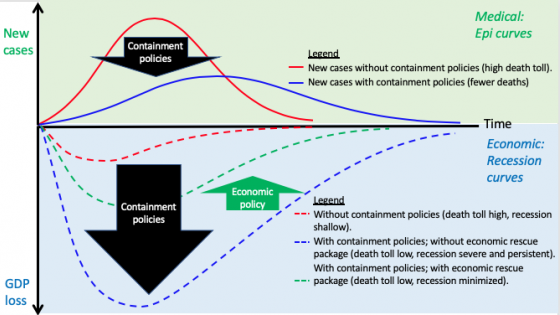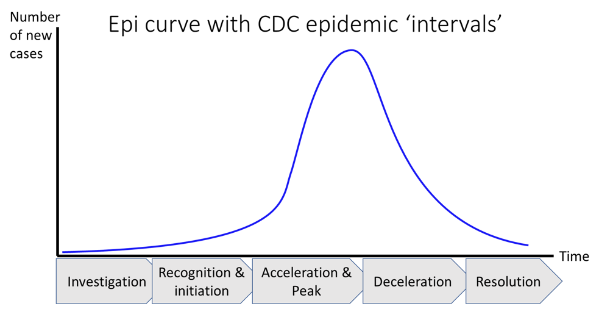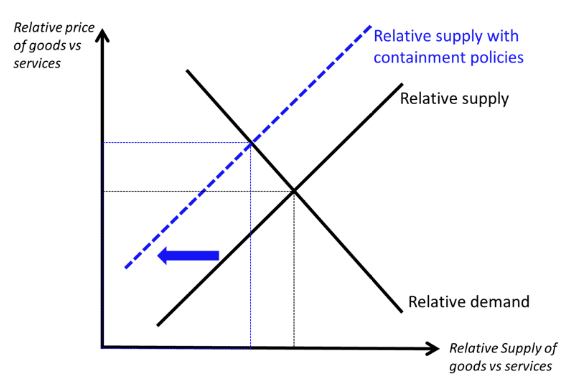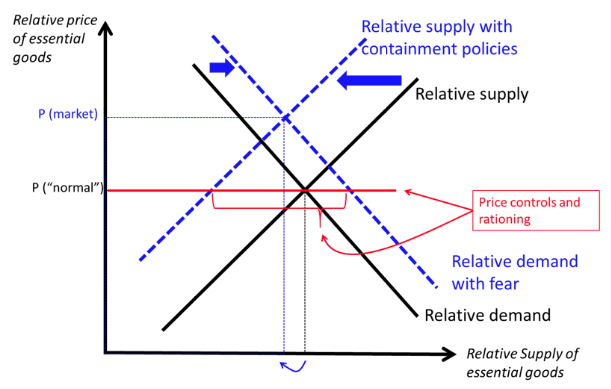COVID-19 is a textbook epidemic, so far.1 In country after country, it follows the classic ‘epi curve’ (short for epidemiological curve) of disease transmission (Figure 1).2 Europe and the US are still in their accelerating phase; China has worked its way to the resolution phase (subsequent waves are possible).
Figure 1 Phases of the classic epidemiological (‘epi’) curve
Source: CDC.gov, www.cdc.gov/flu/pandemic-resources/national-strategy/intervals-framework-508.html
The recession is a public health measure
While only a fraction of new cases require hospitalisation, the daily admissions can overload hospital capacity. This is happening today in Italy and Spain; it happened massively in Wuhan. America will likely suffer the same, according to a Harvard study published this week (Harvard 2020). For central scenarios, “vast communities in America are not prepared to take care of the COVID-19 patients showing up,” said Dr Ashish Jha, Director of the Harvard Global Health Institute (see Figure 2).3
Hospital overloads have tragic consequences. Unable to provide the care that people need to survive, overwhelmed hospitals result in more people dying than would be the case with a slower rate of infection. Reducing the rate of infection is thus a life-and-death imperative.
Figure 2 Harvard’s simulation study of US hospital overload, moderate scenario
Note: the moderate scenario COVID19 infects 40% of adults over 12 months.
Source: Harvard Global Health Institute, online results
Since we have no 21st century tools against COVID-19, slowing infection means putting distance between infected and uninfected people. Given the lack of testing in Europe and the US, the only way to keep the sick and healthy apart is to keep everyone apart. And that produces a recession.
Given the lack of testing in Europe and the US, the only way to keep the sick and healthy apart is to keep everyone apart. And that produces a recession.
In short, the recession is a public health measure. This links the medical and economic aspects of the crisis, creating the ‘two-curves problem’.
The two-curves problem
Because COVID-19 is very infectious but not particularly lethal, the disease itself would have caused a slowdown, but probably not a very large one. The bulk of the coming recession is being caused by the public health measures taken to calm human calamity at the hospitals.
Governments are preventing workers from working (deepening the supply-side recession) and consumers from consuming (deepening the demand-side recession). The recession, in other words, is intentional and unavoidable.
Governments are preventing workers from working (deepening the supply-side recession) and consumers from consuming (deepening the demand-side recession). The recession, in other words, is intentional and unavoidable. What is not unavoidable is the longer-term damage that the containment policies are doing to the economy.
What is not unavoidable is the longer-term damage that the containment policies are doing to the economy. They have put a ‘hard stop’ on production, consumption, and investment and these are damaging the economy in ways that will make the recession longer and deeper than it need be for purely medical reasons.
Fortunately, many governments are reacting in ways that shield their economies from this sort of long-term damage.
How to think about economic ‘shield packages’
Figure 3 schematically illustrates how the containment policies that saves lives (top panel in the figure) also make the recession worse (bottom panel). But economic policy can flatten the recession curve.
Figure 3 The recession, made worse by containment policy, can be mitigated with economic policy.
Source: Author’s elaboration based on Gourinchas (2020).
Think of it this way. Each weekend, the production of most goods and services plummets, so the production-side measure of GDP plummets. This causes little worry since, come Monday morning, all the jobs are still there. All the firms are still in business. All the networks and infrastructures that modern economies rely on are all still there. Workers come back; production resumes.
In the best-case scenario, this is what the COVID-19 economic crisis will look like. Production is plummeting since workers are away from work. But once the medical crisis passes, production will resume since all the jobs, firms, and networks are still there. The goal is to “keep the lights on,” as I put it in Baldwin (2020a).
Many commentators call them ‘stimulus packages’ but really they are ‘shield packages.’ They need to shield jobs, firms, banks, and networks. Additionally, they need to inspire confidence that the economy will return to normal. And they need to protect economically vulnerable citizens.
There is an urgency about this as governments around the world are realising. “Shutting down the economy is not like turning off a light bulb. It's more like shutting down a nuclear reactor. You need to do it slowly and carefully or it may meltdown,” as Cochrane (2020) put it so aptly.
Many commentators call them ‘stimulus packages’ but really they are ‘shield packages.’ They need to shield jobs, firms, banks, and networks. Additionally, they need to inspire confidence that the economy will return to normal. And they need to protect economically vulnerable citizens.
The packages that governments including those of Germany, France and Italy have designed so far are pretty good, in my view – at least given how fast they were thrown together. See Bénassy-Quéré et al (2020) and Bofinger et al. (2020) for systematic thinking on what’s needed in these ‘shield-policy’ packages.
The supply side also matters; spending, production and prices
GDP is a measure of a nation’s income, and a measure of its production – both at the same time. As a matter of logic and accounting identities, the two must be equal. Like it or not, price and quantity adjustments will keep them in sync.
Figure 4 More circular spending with less circular production can lead to inflation.
Source: Author’s elaboration.
Figure 4 illustrates the point with a highly simplified ‘circular flow diagram’ with the ‘real side’ added. The inner circuit (in yellow) shows labour flowing from households to firms and the goods and services produced by businesses flowing to the households. The outer circuit (in grey) show the monetary side, i.e. the flow of income and spending.
COVID-19 and the containment policies have directly and massively reduced the flow of labour to businesses. The result has been a sudden and massive reduction in the output of goods and services. Different goods and services are hit differently – and I’ll make a big deal of that below – but for now, let’s just “simplify to clarify” and say the value of real production falls.
The gigantic government stimulus packages stimulate spending – or more precisely, keep spending from falling as much as it would otherwise. The gigantic containment policies reduce production. In the short run, advanced, open economies have enough slack and inventory to allow supply and demand to match without big price changes. But what about in a month or so?
When stocks and inventories run low, the price system will match the dampened quantities and stimulated spending in the usual way. Prices will rise.
When stocks and inventories run low, the price system will match the dampened-quantities and stimulated-spending in the usual way. Prices will rise.
I’m not saying the solution is to not stimulate – we have to ‘keep the lights on’. We have to shield firms, jobs, and the financial system. But we cannot forget about the supply side this time, even though we usually can.
In normal times, the supply side looks after itself. Or more precisely, there is an army of entrepreneurs, and firms willing to look after it for us in exchange for a profit. Normally, firms are eager, willing and able to meet any demand. In normal recessions, the big problem is a lack of demand. This time is different because government supply-side policies (the containment policies) are causing the recession.
What’s the takeaway? Cutting back on output with containment policies while boosting spending with stimulus packages is likely to be inflationary. That’s not all bad in these deflationary times, but it could get out of hand – as it did in the 1970s.
Relative supply also matters – biased supply cuts and relative prices
The widespread work-from-home directives have a biased impact on the output of goods and services. Many service tasks can be done remotely but most production of goods requires social proximity, not social distancing.4
If lockdowns were to apply to all jobs (and I’ll argue below that they shouldn’t), there would be a shift in the relative supply of goods versus services. This almost surely will result in higher relative prices for goods. Thus, the higher prices suggested by Figure 5 may be especially marked when it comes to goods.
This analysis is too simplified, of course. One needs to distinguish durable verses non-durable goods, and in-person services verses digital services, for instance, but the basic point stands – containment policies will change relative prices since they’ll shift relative supplies. The point is made in Figure 5, which is a version of the classic Krugman-Obstfeld relative supply and demand diagram.
Figure 5 Relative supply shifts: Services are easier to produce remotely.
Source: Author’s elaboration.
Containment policies that keep people apart will produce an inward shift of the relative supply curve of goods versus services. If the relative demand for goods stays put or shifts out, the result will be higher relative prices for goods.
Containment policies that keep people apart will produce an inward shift of the relative supply curve of goods versus services …the result will be higher relative prices for goods.
Since people need some goods to survive, and price rises are unpopular, governments will want to think in more nuanced terms about the containment policies. Production workers may need to be exempted – and provided with protective gear to ensure they don’t give each other COVID-19.
Achieving minimum essential production with fairness
The last supply-side point is one familiar to students of wartime economies. A combination of basic economics and inescapable political economy often leads to rationing, price controls, and government mandated (or subsidised) production.
The last supply-side point is familiar to students of wartime economies. A combination of basic economics and inescapable political economy often leads to rationing, price controls, and government mandated (or subsidised) production.
Figure 6 helps organise thinking on this matter. Here, the relative supply curve differs from Figure 5. The relative supply is of essential goods versus everything else. As mentioned, keeping workers away from work depresses output – especially the output of physical goods since such production requires physical presence of workers in factories, and their delivery requires supply-chain staffing.
The resulting reduction of the relative supply of essential goods is shown as the rightward shift in the diagram from the black solid relative supply curve to the blue dashed one. Citizens who are afraid, or at least worried, are likely to raise their relative demand for essential goods, which, in turn, shifts the relative demand outwards as shown. The market for essential good now clears at a high price, and lower availability (for the shifts illustrated). But that’s not the end of the story.
High prices for essential goods will strike citizens as unfair, maybe even unacceptable. History has shown time and time again that this combination can generate political forces that result in price controls (to keep the price down) and rationing (to allocate the scarce goods).
Will we see this in the coming months? It is a clear possibility – especially in nations where the electorate is socially minded. Rationing, of course, is not the only possibility. There are many other options. In fact, this is basically an opening for Econ101 teachers to motivate analysis of price ceilings, production quotas, the details of various rationing schemes, vouchers, tied income support, and the like.
Figure 6 Essential goods dilemma – high prices or less availability
Source: Author’s elaboration.
High prices for essential goods will strike citizens as unfair, maybe even unacceptable. History has shown time and time again that this combination can generate political forces that result in price controls (to keep the price down) and rationing (to allocate the scarce goods).
Concluding remarks
“Go big. Act Fast. Keep the lights on,” is still good advice for governments trying to solve the ‘two-curves problem’. What I’ve pointed out here is that demand-side stimulus spending combined with public health containment policies is probably going to cause prices to rise and other supply-side problems that need to be address.
There will be relative-price changes that may trigger irresistible calls for price controls and rationing. There may be general price increases if the output measure of GDP does not keep up with the stimulus-repaired spending. And lockdown policies will have to be sufficiently nuanced to permit economies to maintain or ramp up the production of essential goods.
This last point is important. In normal times, governments can leave production to the private sector. Governments don’t have to know anything about logistics, supply chains, or production schedules since an army of entrepreneurs and firms are looking after those things in exchange for a profit.
But in normal times governments don’t dictate business closures. The implication is that governments will have to undertake detailed thinking on production networks not undertaken since the 1940s. The containment policies will need to be intelligently crafted. And the longer the containment policies last, the more important it will be for them to be intelligent, flexible and well-informed.
If the containment policies are lifted in a couple of weeks, this won’t be an issue. But in my view, they will be in place much longer. They’ve been in place in Italy, for example, in various forms for over a month now. In reviewing China’s experience with containment policies that defeated COVID-19’s first wave, Huang (2020) points out that an entire province was locked down for two months. The period would have been longer if the lockdown hadn’t started so early and been enforced so strictly.
References
Baldwin, R (2009), The great trade collapse: causes, consequences and prospects, a VoxEU.org, eBook, CEPR Press.
Baldwin, R (2020), “It’s not exponential: an economist’s view of the epidemiological curve,” VoxEU.org, 12 March. ADD HYPERLINK PLEASE
Baldwin, R and B Weder di Mauro (eds) (2020a), Economics in the Time of COVID-19, a VoxEU.org eBook, CEPR Press.
Baldwin, R and B Weder di Mauro (eds) (2020b), Mitigating the COVID economic crisis: Act fast and do whatever it takes, a VoxEU.org eBook, CEPR Press.
Bems, R, R Johnson and K-M Yi (2012), “The Great Trade Collapse”, Annual Review of Economics.
Benassy-Quéré, A, R Marimon, J Pisani-Ferry, L Reichlin, D Schoenmaker, B Weder di Mauro (2020) “COVID-19: Europe needs a catastrophe relief plan,” VoxEU.org, 11 March.
BIS – Bank for International Settlements (2019), Annual Economic Report.
Blinder, A and A B. Krueger (2009), “Alternative Measures of Offshorability: A Survey Approach,” NBER Working Paper 15287.
Bofinger, P, S Dullien, G Felbermayr, C Fuest, M Hüther, J Südekum and B Weder di Mauro (2020), “Economic implications of the COVID-19 crisis for Germany and economic policy measures,” in R Baldwin and B Weder di Mauro (eds), Mitigating the COVID economic crisis: Act fast and do whatever it takes, a VoxEU.org eBook, CEPR Press.
Cochrane, J (2020), “Coronavirus monetary policy,” in R Baldwin and BWeder di Mauro (eds), Economics in the Time of COVID-19, VoxEU.org eBook. ADD HYPERLINK.
Debt.org (2020), Bankrupcy Statistics.
Ferguson, N M, D Laydon, G Nefjati-Gelani et al. (2020), “Impact of non-pharmaceutical interventions (NPIs) to reduce COVID-19 mortality and healthcare demand”, Imperial College COVID-19 Response Team.
Gourinchas, Pierre-Olivier (2020). “Flattening the pandemic and recession curves,” Chapter 2 in R Baldwin and B Weder di Mauro (eds), Mitigating the COVID economic crisis: Act fast and do whatever it takes, a VoxEU.org eBook, CEPR Press.
Harvard Global Health Institute (2020), “Caring for covid-19 patients can hospitals around the nation keep up?”, online results.
Huang, Y, C Lin, P Wang and Z Xu (2020), “Saving China from the coronavirus and economic meltdown: Experiences and lessons,” in R Baldwin and B Weder di Mauro (eds), Mitigating the COVID economic crisis: Act fast and do whatever it takes, a VoxEU.org eBook, CEPR Press.
IMF (2020), World Economic Outlook, January 2020.
Liu, Y, A A Gayle, A Wilder-Smith, and J Rocklöv (2020), “The reproductive number of COVID-19 is higher compared to SARS coronavirus”, Journal of Travel Medicine 27(2).
Mankiw, G (2010), Macroeconomics (7th edition), Worth Publishers.
Endnotes
1 In the sense the epidemiologists are using the standard tools, such as R0, to analyse it (Ying 2020).
2 See daily case data on ECDC.europa.eu.
3 See Harvard Global Health Institute (2020) in the references for this online study.
4 So which are these? One place to start would be Blinder and Kreuger (2009) – a study that quantifies the offshore-ability of occupations (assuming offshorable jobs are more likely to be able to be done remotely).










